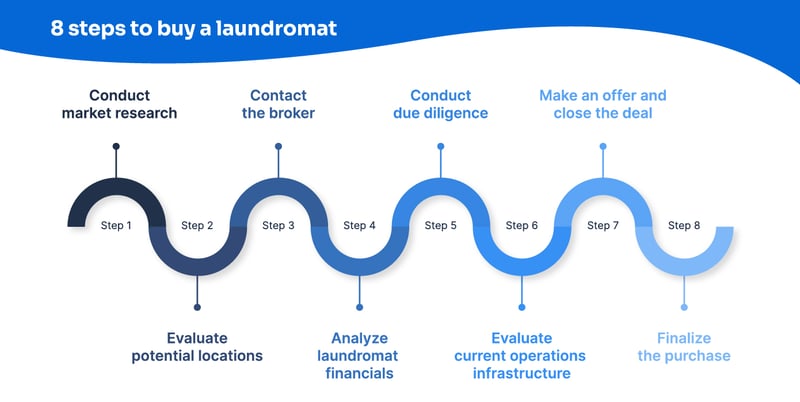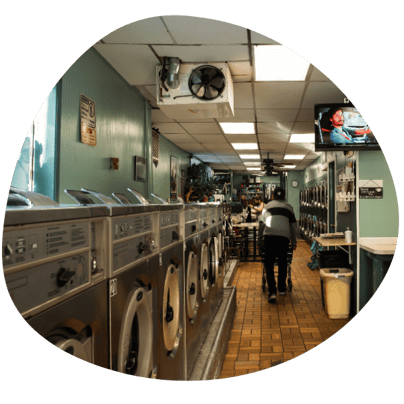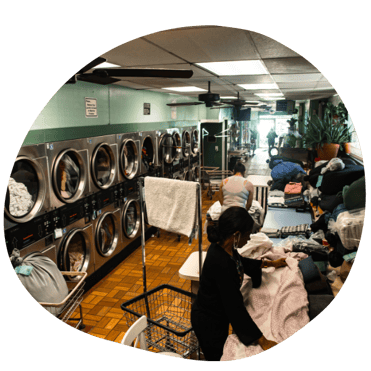You may be wondering how much a laundromat can make. The average gross income of a laundromat ranges from $150,000 to $600,000 annually, with variations depending on factors like location, size, and services offered. This data underscores not only the potential for substantial income but also the scalability of the business model.
Steady cash flow, non-perishability of service, high ROI, and industry stability make purchasing a laundromat an excellent financial decision for new and seasoned entrepreneurs alike.
 Step 1: Conduct thorough market research
Step 1: Conduct thorough market research
Conducting thorough market research is the foundation for any smart investment. This initial phase lays the groundwork for a profitable laundry business by providing a deep understanding of the local market and consumer base.
Market research involves several elements:
-
Analyzing local demographics: In order to accurately assess the demand for laundromat services, you need a deep understanding of your local demographic. These factors include population density, average household income, and lifestyle habits. Areas with high population density, especially cities with a significant number of rental properties, are typically ideal for laundromats. These areas carry a demographic profile often including working-class families and young professionals who may not have in-home laundry facilities, which results in a steady customer base reliant on laundromat services.
-
Evaluating consumer behavior: Consumer behavior in the area can offer insights into the potential success of a laundromat. This includes understanding the local community's laundry habits and preferences. For example, some communities might prefer wash-and-fold services due to busy lifestyles, while others might favor self-service options. Analyzing consumer behavior can help tailor the laundromat's services to meet the needs of the community.
-
Assessing existing laundromats: Investigating existing laundromats for sale provides valuable information about the market competition. This includes taking a hard look at the condition, services offered, pricing strategy, and customer base of these laundromats. Understanding why a particular laundromat is for sale is also important—it could be due to retirement, market saturation, or poor management, each of which presents different implications for you as a potential buyer.
-
Studying market trends: Keeping up-to-date of current trends in the laundromat industry can benefit you in your acquisition. This may involve exploring the latest technologies, environmentally friendly practices, or innovative business models like pickup and delivery.
Conducting thorough market research is not just about finding a laundromat for sale—it’s about understanding the environment in which you’ll attempt to grow a profitable business. That’s why this research is such an important first step in your journey!
Step 2: Evaluate potential laundromat locations
Choosing a central location for your laundromat is integral in it’s success. Since laundromats are brick-and-mortar businesses, you have to consider the major elements that make a good location.
How to evaluate a laundromat business
When investing in laundromats, it's essential to conduct thorough due diligence. Key factors to consider include:
-
Financial performance: Review profit and loss statements, tax returns, and utility bills to assess revenue and expenses.
-
Location analysis: Evaluate the neighborhood demographics, competition, and accessibility to determine the potential customer base.
-
Competition: Research the presence of other laundromats in the vicinity. If there are multiple competitors nearby, it may be challenging to establish a new laundromat. On the other hand, a lack of quality laundry services in the area can present an opportunity.
-
Parking and accessibility: Easy access and ample parking are important for attracting customers who prefer to drive. The last thing customers want when lugging laundry is to struggle to find parking near your storefront.
-
Zoning and regulation: Check local zoning laws and regulations to ensure that a laundromat is permitted in the area you’re looking at.
-
Lease terms: Understand the lease terms of the potential location. Favorable lease conditions, like long-term leases with renewal options, can provide stability for your business.
-
Utility costs: Since laundromats use a great deal of water and electricity, be sure to assess the utility costs of the location. Lower utility costs can significantly impact the profitability of the laundromat.
-
Building and equipment condition: Examine the condition of the building where the laundromat will be located. Inspect the age, condition, and maintenance records of the machines to anticipate future capital expenditures.
By systematically evaluating these aspects, you can make an informed decision and maximize your laundry business investment.
Finding laundromats for sale
When you start the shopping process, you should limit your search to reputable sources. These websites not only provide a broad spectrum of listings but also offer detailed information about each property, allowing you to get an accurate picture of what you’re buying:
BizBuySell stands out as a comprehensive marketplace for buying and selling businesses, including laundromats. What makes BizBuySell particularly useful is its user-friendly interface and the depth of information provided for each listing. You can find details about the business's financial performance, location, asking price, and even the reason for selling.
LoopNet is another great commercial real estate platform that offers a wide array of listings with comprehensive information on each property. LoopNet’s strength lies in its ability to filter searches based on specific criteria such as location, price, and property type, making it easier for investors to find laundromats that meet their exact requirements.
When shopping, look beyond the basic details and consider how each laundromat aligns with your investment goals and criteria. The perfect laundromat investment is not just about the right price; it’s about the right fit for your business strategy and goals.
Step 3: Contact a laundromat broker
Brokers play a crucial role in laundry business investment by providing expert advice on valuation, legalities, and negotiations. They assess the laundromat's financial status, market standing, and growth prospects to establish a justifiable sale price.
Choosing between a broker and a direct sale
Choosing between a broker and a direct sale depends largely on your experience and comfort level in handling real estate transactions. Direct sales might offer a more hands-on approach and potentially lower costs, as they eliminate broker fees. However, they require a deep understanding of the laundromat business, market valuations, and negotiation skills. Opting for a direct sale, you leave yourself vulnerable to costly errors that may hurt your profitability before you even get the chance to open the doors.
On the other hand, brokers bring a wealth of knowledge and experience. Their expertise in the legal, financial, and operational aspects of laundromat transactions can streamline the process, making it more efficient and less stressful for first-time buyers like you!
The integral role of a laundromat broker
Brokers are a major asset in the laundromat buying process, providing expert advice valuation, legalities, and negotiations. They assess the laundromat's financial status, market standing, and growth prospects to establish a justifiable sale price. Their negotiation skills are key to arriving at an agreement that benefits both buyer and seller.
Initiate contact with a broker
Reaching out to a broker begins with research. Look for brokers with a proven track record in the laundromat industry. When making initial contact, be clear about your investment goals, budget, and the specific type of laundromat you are interested in. This clarity helps the broker to understand your requirements and find listings that align with your goals.
Build a relationship with the broker
Establishing a strong relationship with your broker is key to a successful purchase. Be transparent about your expectations and concerns. Regular communication will allow you to keep them informed about any changes in your investment strategy or financial situation.
Leverage the broker's expertise
A broker's knowledge goes beyond just the sale process. They can provide insights into the current trends in the laundromat industry, advice on potential renovations or upgrades, and guidance on how to maximize the business's profitability post-purchase. Utilize their expertise to secure a good deal and set a strong foundation for your investment.
Step 4: Conduct a comprehensive financial analysis
When considering the purchase of a laundromat, a meticulous examination of its financial health is the only way to truly safeguard yourself from a poor investment.
Review the financial statements
Begin by scrutinizing the laundromat's financial records, including profit and loss statements, balance sheets, and cash flow statements from the past several years. Historical financial data will allow you to truly understand the business's trajectory.
Verify revenue sources
A critical aspect of the financial assessment is verifying the laundromat's revenue sources. This includes standard laundry services, wash-and-fold options, vending machines, and any added services the business might offer. For an unbiased valuation, consider ordering a professional appraisal, which can provide an independent and objective assessment of the laundromat’s worth.
Assess operating expenses
Thoroughly analyze all operational costs associated with the laundromat including utilities, maintenance, staffing expenses, insurance premiums, and any lease or mortgage payments. Getting documentation of these expenses is key to evaluating the business's net income and identifying areas where you can potentially cut costs.
Inspect lease agreements and terms
If the laundromat operates on a leased property, review the lease agreement carefully. Pay attention to the lease duration, renewal options, and any specific clauses that could affect future success. The terms of the lease can significantly impact the long-term viability of the laundry business.
Evaluate potential for laundromat growth
Assess the laundromat's potential for growth or expansion. Investigate opportunities for additional services, technology upgrades, or expansion to new locations. This forward-looking analysis will help you understand the scalability and future revenue streams.
Calculate return on investment (ROI)
Calculating the expected ROI and payback period is an important step in confirming financial feasibility of the purchase. The payback period is the time required to recover the cost of an investment. It is calculated by dividing the initial amount invested in the laundromat by the annual cash flow it generates. For instance, if you invest $300,000 in a laundromat and it generates an annual cash flow of $60,000, the payback period would be $300,000 / $60,000 = 5 years. Utilize tools like this Laundromat Profit Calculator for precise calculations.
Step 5: Conduct laundromat due diligence and legalities
Purchasing a laundromat requires rigorous due diligence, a process that encompasses not only a review of financials and operations but also a thorough legal check and adherence to local regulations and licensing requirements. Keep reading to learn what you should look for in the due diligence process.
Frequently asked questions when buying a laundromat
-
What is the laundromat's average monthly revenue and profit?
-
How old are the machines, and what is their maintenance history?
-
Are there any existing service contracts or warranties on the equipment?
-
What are the terms of the current lease agreement?
-
Is the laundromat compliant with all local zoning and environmental regulations?
-
What is the competitive landscape in the area?
-
Are there opportunities to increase revenue through additional services or extended hours?
Understanding legal checks and compliance
-
Legal checks: This involves verifying the laundromat's compliance with all legal requirements. It's important to know that the business has been operating within the law, which includes checking for any pending or past litigation.
-
Local regulations: Different areas have local laws governing laundromats. Familiarize yourself with these regulations to confirm that the laundromat is in compliance. This may include health and safety standards, environmental regulations, and specific laundromat operation laws.
-
Licensing requirements: Secure all necessary business licenses and permits to avoid any legal complications and business interruptions.
Reviewing utility costs and agreements
Utility costs are a significant expense for laundromats. Review the utility bills to understand the average monthly costs and audit the efficiency of the current setup. Don’t forget to also check for any existing utility agreements or contracts.
Conducting laundromat due diligence
Comprehensive due diligence for laundromats includes:
-
Financial health check: Examine the laundromat's financial records in detail. Assess the profit margins, cash flow, and any outstanding debts or financial obligations.
-
Operational review: Look into the operational aspects such as equipment condition, maintenance schedules, employee contracts, and customer satisfaction levels.
-
Market analysis: Understanding the local market dynamics, competitor analysis, and customer demographics will provide insight into the laundromat’s current market position and potential for growth.
The goal of this step is to uncover any potential red flags or areas that might need improvement. It’s advisable to involve legal and financial experts for a thorough and professional due diligence process.
Step 6: Evaluate current laundromat operations infrastructure
This process involves a detailed assessment of staff and management, as well as the existing technology, which will give insight into whether or not the business handles operational challenges efficiently.
Staff and management evaluation
Begin by examining the roles and effectiveness of any existing staff. This includes understanding their responsibilities, skills, and contributions to the business. Retaining or retraining staff should align with your business objectives and the desired customer experience. Assess whether the current team can adapt to potential changes or improvements you plan to introduce.
Technology assessment
Technology plays a critical role in modernizing laundromats. Consider upgrading to advanced systems for payment processing and operational management.
-
Payment systems: Upgrading to modern payment systems is not just about convenience; it's about improving customer experience and streamlining transactions. Systems like Cents Business Management offer integrated solutions for payment processing, allowing customers to use various payment methods and allowing you to increase your revenue.
-
Security: Enhancing security measures through modern surveillance and alarm systems allows you to protect your assets and deliver customer safety. This includes both physical security and cybersecurity measures for protecting customer data.
-
Operational efficiencies: Leveraging the power of comprehensive management software can significantly boost operational efficiency. Cents Laundry Pickup & Delivery and Card Payment Technology offer tools for business management, from scheduling and dispatching for pickup and delivery services to seamless communication and customer relationship management.
Incorporating advanced tools modernizes the laundromat, makes your customers’ lives easier, creates more revenue opportunities for you, and provides a competitive edge in the market.
Step 7: Make an offer and close the deal
You're in the home stretch! After navigating the complexities of finding, evaluating, and making strategic decisions about your prospective laundromat, you're poised to finalize the deal.
Prepare the offer
When you're ready to make an offer on a laundromat, it's essential to prepare a proposal. This should include the purchase price, which is based on your valuation of the business, as well as the terms of sale. Be sure to incorporate any contingencies, such as securing financing for your laundromat or achieving satisfactory results from a final inspection.
Negotiate the sale
Negotiating the sale of a laundromat can be a complex process. The seller may counter your initial offer, which could lead to a series of negotiations. It's important to stay focused on your valuation and business goals during this process. Keep in mind, negotiation encompasses the price as well as terms and conditions that can affect your business in the long run.
Secure financing
If financing hasn't already been secured, it's time to finalize it once your offer is accepted. This involves presenting the lender with the laundromat's financial statements, your business plan, and details of the transaction. Make sure to have a well-prepared and realistic business plan that shows your ability to repay the loan.
Conduct final due diligence
Even after the offer is accepted, you should conduct a final due diligence phase. This may include a thorough inspection of the premises to ensure that everything is consistent with what came of the negotiations. It's important to verify that all aspects of the laundromat, such as the condition of equipment and compliance with local regulations, are in line with your expectations and the terms of the sale.
Closing documentation and entering escrow
The final step in the acquisition process is preparing and reviewing all closing documents. This normally includes the bill of sale, transfer of leases and contracts, and any other legal documents required to transfer ownership. It's advisable to have legal and financial professionals review these documents to ensure everything is in order. Entering escrow is the final stage of the transaction, where funds and documents are held by a third party until all conditions of the sale are met.
Step 8: Finalize the purchase
Congratulations! Finalizing the purchase of your laundromat is a significant milestone. The transition following purchase involves integrating staff, updating technology, and establishing clear communication channels with customers and suppliers. Here are the key steps for a smooth transition:
-
Create a transition plan: A well-structured transition plan is essential for a seamless changeover. This includes understanding the existing operational procedures and identifying areas that require immediate attention or improvement. If the laundromat has existing staff, evaluate their roles and effectiveness. Deciding whether to retain current employees or hire new staff will impact the continuity and quality of service. It's also an opportunity to infuse new ideas and practices into the business.
-
Communicate changes with customers and suppliers: For customers, this might involve announcing new ownership, any forthcoming changes in services or pricing, and reassurances about the quality and continuity of service. Effective communication strategies could include in-store signage, social media announcements, and direct emails. For suppliers, introduce yourself and discuss any contractual agreements or changes in operations that might affect your relationship.
-
Implement technology: Upgrading technology can significantly enhance operational efficiency by automating many time-consuming and mundane tasks. Modern solutions like Cents also contribute to increased satisfaction and higher-value sales. Implementing these from the get-go allows you to hit the ground running as soon as you open and set the tone for long-term growth.
Pre-purchase considerations for understanding your laundry business investment
Opening a laundromat is only a good investment if you’re willing to diligently plan for financial success.
What makes a laundromat a good investment?
-
Steady cash flow: Laundromats typically offer a consistent stream of income. The demand for laundry services is relatively inelastic year-round.
-
Recession resistance: Economic downturns have less impact on laundromats, as they provide essential services.
-
Scalable business model: There's potential for growth through additional services like wash-and-fold, pickup and delivery, commercial customers, or dry cleaning.
Importance of location, community demand, and competition analysis
-
Location: Ideal locations are in high-density residential areas or near colleges where many residents may not have in-house laundry facilities.
-
Community demand: Understand the needs of the local population. Are they looking for basic services, or do they value added conveniences like delivery?
-
Competition analysis: Assess the number and quality of nearby laundromats. A saturated market might necessitate a unique value proposition to stand out.
Financial planning for your laundromat
Budget considerations: Include the purchase price, potential renovation costs, and necessary operating capital. Accurate budgeting is essential for sustainability and growth.
Financing options:
-
Loans: Banks offer different loans, including SBA loans, with a variety of terms and rates.
-
Investors: Bringing in investors can provide the necessary funds but may involve sharing profits and decision-making.
-
Personal capital: Using personal savings reduces debt but requires significant upfront personal financial commitment, especially considering the average cost of a laundromat can range from several tens of thousands to more than a million dollars.
How much working capital is needed after purchasing a laundromat?
The amount of working capital needed after purchasing a laundromat varies based on factors like size, location, and business plan. You need leftover cash post-sale to cover ongoing expenses like utilities, maintenance, marketing, and cash flow gaps. A detailed financial forecast and local market conditions can help determine the specific amount needed.
Next steps for investing in a laundromat
Now that you have the complete roadmap for how to buy a laundromat, you’re well prepared to start on the path of a laundromat investor! The process is long and detailed, but through thorough research, careful planning, and leveraging the right resources, you’ll soon find success in a profitable laundromat of your own.
Buying a laundromat may feel intimidating, but know that the laundry experts at Cents have your back every step of the way. Our range of tools and solutions designed specifically for laundromat owners, can help you optimize operations, enhance customer experiences, and drive profitability. In other words, we’ll handle the logistics so you can focus on the important stuff: enjoying your new income stream!
With the right knowledge, tools, determination, and laundromat technology partner you're well-equipped to build the thriving laundromat business of your dreams!
Want to learn more about how we can help? Schedule a no-pressure call with a Cents rep.
Grow your market, tap into new revenue sources, or update the customer experience. Whether you have one store, multiple stores, or just getting started in the industry, Cents has the one system you need to grow, manage, and understand your business.
.png?width=2196&height=2196&name=OS%20(1).png)

-3.png?width=224&height=213&name=Accelerate%20(2)-3.png)










